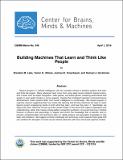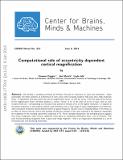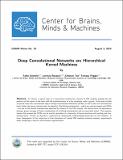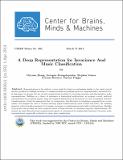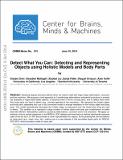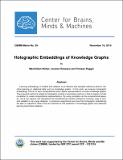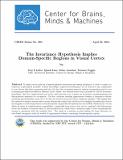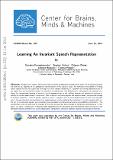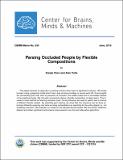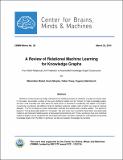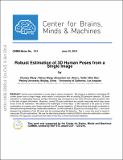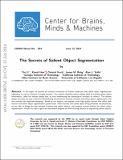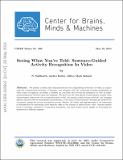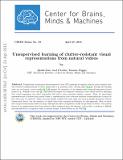Browsing CBMM Memo Series by Subject "Machine Learning"
Now showing items 1-14 of 14
-
Building machines that learn and think like people
(Center for Brains, Minds and Machines (CBMM), arXiv, 2016-04-01)Recent progress in artificial intelligence (AI) has renewed interest in building systems that learn and think like people. Many advances have come from using deep neural networks trained end-to-end in tasks such as object ... -
Computational role of eccentricity dependent cortical magnification
(Center for Brains, Minds and Machines (CBMM), arXiv, 2014-06-06)We develop a sampling extension of M-theory focused on invariance to scale and translation. Quite surprisingly, the theory predicts an architecture of early vision with increasing receptive field sizes and a high resolution ... -
Deep Convolutional Networks are Hierarchical Kernel Machines
(Center for Brains, Minds and Machines (CBMM), arXiv, 2015-08-05)We extend i-theory to incorporate not only pooling but also rectifying nonlinearities in an extended HW module (eHW) designed for supervised learning. The two operations roughly correspond to invariance and selectivity, ... -
A Deep Representation for Invariance And Music Classification
(Center for Brains, Minds and Machines (CBMM), arXiv, 2014-17-03)Representations in the auditory cortex might be based on mechanisms similar to the visual ventral stream; modules for building invariance to transformations and multiple layers for compositionality and selectivity. In this ... -
Detect What You Can: Detecting and Representing Objects using Holistic Models and Body Parts
(Center for Brains, Minds and Machines (CBMM), arXiv, 2014-06-10)Detecting objects becomes difficult when we need to deal with large shape deformation, occlusion and low resolution. We propose a novel approach to i) handle large deformations and partial occlusions in animals (as examples ... -
Holographic Embeddings of Knowledge Graphs
(Center for Brains, Minds and Machines (CBMM), arXiv, 2015-11-16)Learning embeddings of entities and relations is an efficient and versatile method to perform machine learning on relational data such as knowledge graphs. In this work, we propose holographic embeddings (HolE) to learn ... -
The Invariance Hypothesis Implies Domain-Specific Regions in Visual Cortex
(Center for Brains, Minds and Machines (CBMM), bioRxiv, 2015-04-26)Is visual cortex made up of general-purpose information processing machinery, or does it consist of a collection of specialized modules? If prior knowledge, acquired from learning a set of objects is only transferable to ... -
Learning An Invariant Speech Representation
(Center for Brains, Minds and Machines (CBMM), arXiv, 2014-06-15)Recognition of speech, and in particular the ability to generalize and learn from small sets of labelled examples like humans do, depends on an appropriate representation of the acoustic input. We formulate the problem of ... -
Parsing Occluded People by Flexible Compositions
(Center for Brains, Minds and Machines (CBMM), arXiv, 2015-06-01)This paper presents an approach to parsing humans when there is significant occlusion. We model humans using a graphical model which has a tree structure building on recent work [32, 6] and exploit the connectivity prior ... -
A Review of Relational Machine Learning for Knowledge Graphs
(Center for Brains, Minds and Machines (CBMM), arXiv, 2015-03-23)Relational machine learning studies methods for the statistical analysis of relational, or graph-structured, data. In this paper, we provide a review of how such statistical models can be “trained” on large knowledge graphs, ... -
Robust Estimation of 3D Human Poses from a Single Image
(Center for Brains, Minds and Machines (CBMM), arXiv, 2014-06-10)Human pose estimation is a key step to action recognition. We propose a method of estimating 3D human poses from a single image, which works in conjunction with an existing 2D pose/joint detector. 3D pose estimation is ... -
The Secrets of Salient Object Segmentation
(Center for Brains, Minds and Machines (CBMM), arXiv, 2014-06-13)In this paper we provide an extensive evaluation of fixation prediction and salient object segmentation algorithms as well as statistics of major datasets. Our analysis identifies serious design flaws of existing salient ... -
Seeing What You’re Told: Sentence-Guided Activity Recognition In Video
(Center for Brains, Minds and Machines (CBMM), arXiv, 2014-05-29)We present a system that demonstrates how the compositional structure of events, in concert with the compositional structure of language, can interplay with the underlying focusing mechanisms in video action recognition, ... -
Unsupervised learning of clutter-resistant visual representations from natural videos
(Center for Brains, Minds and Machines (CBMM), arXiv, 2015-04-27)Populations of neurons in inferotemporal cortex (IT) maintain an explicit code for object identity that also tolerates transformations of object appearance e.g., position, scale, viewing angle [1, 2, 3]. Though the learning ...

